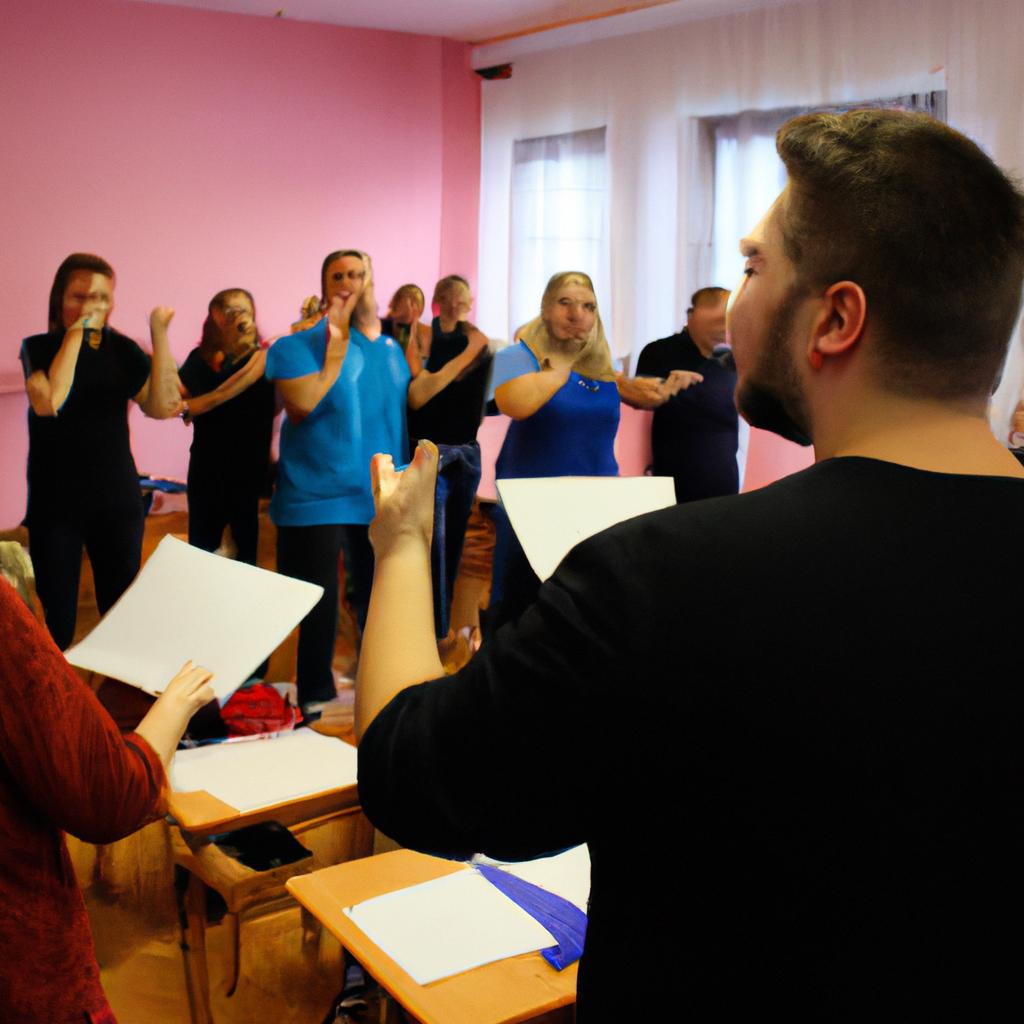Breathing exercises play a pivotal role in enhancing the vocal ensemble and fostering effective choir techniques. The ability to control breath not only allows for greater musical expression but also contributes to overall vocal health and stamina. For instance, imagine a hypothetical scenario where a choir is preparing for an important performance. Without proper breathing techniques, the singers may struggle to sustain long phrases or maintain consistent vocal quality throughout the piece. Therefore, understanding and implementing appropriate breathing exercises can greatly impact the success of a vocal ensemble.
In order to fully comprehend the significance of breathing exercises in choral settings, it is essential to understand their physiological implications. When singers engage in deep diaphragmatic breathing, they are able to access more air capacity which leads to increased resonance and power in their voices. This technique aids in sustaining long notes effortlessly while maintaining tonal clarity and projection. Additionally, practicing specific breathing exercises helps strengthen the muscles involved in respiration, leading to improved lung function and endurance during performances. By incorporating these exercises into regular rehearsal routines, choirs can develop a shared sense of breath support that enhances their collective sound and cohesion onstage.
The benefits of incorporating breathing exercises extend beyond technical improvement alone; they also have positive effects on singer well-being. Deep breathing has been found to reduce stress levels and promote relaxation. In a choir setting, where singers often experience performance anxiety or stress related to vocal demands, incorporating breathing exercises can help alleviate these negative emotions. By focusing on deep breathing and mindful awareness of the breath, singers can effectively calm their nervous systems and enter a state of mental and physical balance. This not only enhances their overall well-being but also contributes to a more confident and controlled performance.
Furthermore, regular practice of breathing exercises can improve vocal health and prevent vocal fatigue or strain. When singers use proper breath support, they are less likely to rely on tension in the throat or excessive force to produce sound. This reduces the risk of vocal disorders such as nodules or vocal cord damage. Additionally, efficient breath control allows for better airflow and lubrication of the vocal folds, preventing dryness and irritation.
To implement effective breathing exercises in a choral setting, it is essential to work with a knowledgeable choir director or vocal coach who understands the physiological aspects of singing. They can guide the warm-up routines and provide specific exercises tailored to the needs of the ensemble. Some common breathing exercises include diaphragmatic breathing (also known as belly breathing), sustained hissing or sighing sounds, inhaling slowly while counting, or utilizing specific imagery like imagining filling up balloons with each breath.
In conclusion, breathing exercises are crucial for enhancing vocal ensemble skills and promoting healthy singing habits in choirs. By improving breath control, singers can achieve greater musical expression, sustain long phrases effortlessly, and maintain consistent vocal quality throughout performances. These exercises also have positive effects on singer well-being by reducing stress levels and promoting relaxation. Moreover, practicing proper breathing techniques helps prevent vocal fatigue and maintains optimal vocal health. Therefore, integrating regular breathing exercises into choir rehearsals is essential for achieving success both technically and artistically.
Benefits of Breathing Exercises for Vocal Ensemble
Breathing exercises play a crucial role in enhancing the performance of vocal ensembles, such as choirs. By focusing on proper breathing techniques, choir singers can improve their overall vocal quality and endurance. This section will explore the benefits that these exercises bring to vocal ensemble performances.
Case Study Example:
To illustrate the impact of breathing exercises on vocal ensembles, consider a hypothetical scenario involving a community choir preparing for an important concert. Prior to incorporating regular breathing exercises into their rehearsals, many choir members struggled with breath control and experienced fatigue during longer musical passages. However, after implementing a series of targeted breathing exercises over several weeks, noticeable improvements were observed. The singers became more confident in sustaining notes and phrases, resulting in a more cohesive and polished sound during performances.
Emotional Impact:
- Boosts self-confidence: Properly executed breathing exercises provide singers with increased confidence in their ability to produce clear and powerful sounds.
- Enhances relaxation: Engaging in focused breathing activities helps alleviate stress and tension among choir members, creating a harmonious rehearsal environment.
- Promotes unity within the group: Sharing this common practice fosters camaraderie among the ensemble members, leading to stronger bonds and improved teamwork.
- Elevates artistic expression: With improved breath control, singers are better able to express themselves artistically by effectively phrasing melodies and conveying emotions.
Impact Assessment Table:
| Benefit | Description |
|---|---|
| Improved stamina | Regular breathing exercises enhance lung capacity and enable choir singers to sustain long notes |
| Enhanced dynamics | Controlled inhalation and exhalation allow for greater dynamic range |
| Increased resonance | Effective breath support facilitates the production of resonant, fuller vocal tones |
| Improved phrasing | Proper breathing techniques aid in shaping phrases and delivering nuanced interpretations |
These benefits highlight the importance of incorporating breathing exercises into choir rehearsals. In order to fully harness these advantages, it is crucial for singers to understand and practice proper breathing techniques. The following section will delve into specific strategies that can be employed by choir singers to optimize their breath control during performances.
Proper Breathing Techniques for Choir Singers
Benefits of Breathing Exercises for Vocal Ensemble:
Building upon the understanding of the benefits of breathing exercises for vocal ensemble, it is important to explore proper techniques that can be employed by choir singers. By adopting these techniques, individuals can enhance their vocal control and contribute positively to the overall sound of the ensemble.
One example that highlights the impact of proper breathing techniques is a hypothetical case study involving a choir struggling with maintaining consistent pitch during performances. Through implementing specific breathing exercises, such as deep inhalations and controlled exhalations, the singers were able to improve their breath support, resulting in more stable pitch production and harmonious blending within the group.
- Increased lung capacity leading to enhanced projection
- Improved stamina allowing for longer phrases without strain
- Reduced tension in the body promoting relaxation and focus
- Enhanced mental clarity enabling better interpretation of musical nuances
Additionally, let us delve into a three-column table outlining different types of breathing exercises commonly used in vocal ensembles:
| Exercise Type | Description | Benefits |
|---|---|---|
| Diaphragmatic | Focused on engaging and strengthening the diaphragm muscle through deep belly breaths | – Improves breath control |
| Rib Expansion | Involves expanding the ribcage laterally while inhaling deeply | – Enhances lung capacity |
| Breath Suspension | Requires holding one’s breath briefly after inhalation before exhaling | – Develops breath support |
| Resonant Breaths | Emphasizes inhaling using resonance spaces (such as nasal cavities or oral cavity) | – Facilitates resonant singing |
In conclusion, by integrating appropriate breathing exercises into choral training sessions, singers can effectively cultivate various skills essential for vocal ensemble performance. The benefits of these exercises extend beyond pitch stability and blend, encompassing increased lung capacity, improved stamina, reduced tension, and enhanced mental clarity. By understanding the impact of breathing techniques on vocal control, we can now proceed to explore the role of the diaphragm in achieving optimal vocal expression within a choir setting.
Understanding the Diaphragm: Key to Vocal Control
Enhancing Vocal Ensemble: Choir Techniques
Proper breathing techniques for choir singers play a crucial role in enhancing the overall vocal ensemble. In the previous section, we discussed the importance of these techniques and their impact on choral performances. Now, let us delve deeper into understanding the diaphragm as it holds the key to vocal control.
Imagine a scenario where a choir is preparing for an important performance. The conductor notices that some members struggle with breath support, resulting in inconsistent sound quality and limited vocal range. By addressing this issue through proper understanding of the diaphragm’s function, significant improvements can be made.
To understand how the diaphragm affects vocal control, consider the following points:
- The diaphragm acts as a dome-shaped muscle located beneath our ribcage.
- It plays a vital role in inhalation and exhalation during singing.
- Proper utilization of the diaphragmatic muscles allows for better breath management.
- Engaging the diaphragm enables singers to produce sustained, controlled tones.
Let us now explore this concept further by examining its practical implications within choral settings.
| Benefits of Incorporating Diaphragmatic Breathing |
|---|
| Enhanced breath control |
| Increased vocal stamina |
| Expanded dynamic range |
| Improved tone quality |
Incorporating breath support exercises specific to choral warm-ups can yield remarkable results. These exercises focus on gradually engaging and strengthening the diaphragmatic muscles while promoting efficient airflow throughout each singer’s voice production process. For instance, utilizing sustained “hissing” sounds or practicing phrases with extended legato lines can help develop endurance and ensure consistent tonal color across all voices.
By gaining a deep understanding of proper breathing techniques and harnessing the power of our diaphragms, choirs can unlock their full potential as cohesive ensembles. As we move forward into our next section about incorporating breath support in choral warm-ups, we will explore practical strategies and exercises that can further enhance vocal ensemble performances.
Incorporating Breath Support in Choral Warm-ups
Case Study:
Imagine a vocal ensemble preparing for a performance. As they begin singing, their voices lack cohesion and blend, resulting in an unbalanced sound. Despite individual talent, the group struggles to create a unified choral experience. What could be missing? One crucial element often overlooked is breath control.
Breath control plays a vital role in enhancing vocal ensemble performance. It allows singers to sustain long phrases, maintain pitch accuracy, and produce rich tones. By mastering techniques that improve breath support, choirs can elevate their overall musicality and achieve a more impactful presentation.
To harness the power of breath control in the context of vocal ensemble singing, consider the following key points:
-
Proper Posture:
- Aligning the body optimally enables efficient airflow and diaphragmatic engagement.
- Stand tall with relaxed shoulders and an elongated spine.
- Avoid tension in the neck or chest area by releasing any unnecessary muscular tightness.
-
Diaphragmatic Breathing Techniques:
- Engage the diaphragm fully to maximize lung capacity.
- Practice deep inhalations through abdominal expansion rather than shallow chest breathing.
- Gradually release air during exhalation while maintaining steady support from the diaphragm.
-
Coordination with Phonation:
- Coordinate breath intake with precise timing for optimal expression.
- Develop awareness of how inhalations affect vowel production and consonant articulation.
- Cultivate a balance between controlled breath flow and clear articulatory gestures.
-
Dynamic Control:
- Mastering various dynamic levels enhances expressiveness within choral passages.
- Explore different intensities while maintaining consistent tonal quality throughout each phrase.
| Benefits of Improved Breath Control |
|---|
| Enhanced resonance |
| Increased volume |
| Better phrasing |
| Improved diction |
Achieving mastery in breath control requires consistent practice and focused attention. By incorporating these techniques, vocal ensembles can elevate their performances and captivate audiences with resonant tones and expressive musicality.
Transitioning seamlessly to the subsequent section, “Breath Management for Sustaining Long Phrases,” we delve deeper into sustaining breath for extended musical phrases without compromising tonal quality or stamina.
Breath Management for Sustaining Long Phrases
Enhancing Vocal Ensemble: Choir Techniques
In the previous section, we explored the importance of incorporating breath support in choral warm-ups. Now, let’s delve into another crucial aspect of vocal ensemble training – breath management for sustaining long phrases.
Imagine a scenario where a choir is performing a captivating piece that requires singers to sustain long and demanding phrases. Without proper breath management techniques, it becomes challenging for individual singers to maintain control over their voices and project with power throughout these passages.
To overcome this challenge, choirs can employ various strategies to enhance breath management and enable singers to sustain long phrases effectively. Here are some key techniques:
-
Diaphragmatic Breathing: Encourage singers to engage their diaphragm while inhaling deeply. This technique allows for greater lung capacity and better control over exhalation during extended phrases.
-
Controlled Release: Teach singers how to release air gradually and evenly when singing sustained notes or phrases. This controlled release prevents strain on the vocal cords and promotes smoothness in sound production.
-
Phrasing Awareness: Emphasize the importance of understanding musical phrasing within each line or phrase of music. By highlighting natural points of breathing within the composition, singers can plan inhalations strategically, ensuring uninterrupted airflow throughout longer sections.
-
Breath Markings: Introduce specific markings in sheet music to indicate optimal moments for taking quick but discreet breaths during sustained passages. These markings serve as visual cues for singers and help them navigate complex musical lines more efficiently.
By implementing these techniques, choirs can achieve improved breath management among their members, leading to enhanced performances characterized by sustained power and control throughout even the most challenging pieces.
“.
Breathing Exercises to Improve Vocal Resonance
Building upon the importance of breath management, this section focuses on specific breathing exercises that can enhance vocal resonance and overall performance quality in a vocal ensemble setting. By incorporating these techniques into choir rehearsals, singers can develop greater control over their breath support, leading to improved tonal clarity and blend within the ensemble.
To illustrate the effectiveness of targeted breathing exercises, let us consider a hypothetical case study involving a collegiate chamber choir preparing for an important competition. The conductor noticed that some members were struggling with sustaining resonant tones throughout extended phrases, resulting in unevenness and compromised choral sound. To address this issue, they introduced a series of breathing exercises aimed at enhancing vocal resonance and cohesion within the group.
The following bullet point list demonstrates how these exercises positively impacted the choir’s performance:
- Increased awareness of diaphragmatic engagement
- Enhanced ability to maintain consistent airflow during sustained notes
- Improved control over dynamic changes within phrases
- Heightened sensitivity to vowel formation and resonance placement
In addition to these exercises, an accompanying table showcases four key techniques implemented by the conductor during rehearsals:
| Technique | Description | Benefits |
|---|---|---|
| Breath Suspension | Pausing briefly after inhaling before exhaling | Allows for controlled release of air |
| Lip Trills | Vibrating lips while producing sound | Develops breath control and smooth tone transitions |
| Straw Phonation | Singing through a straw or similar device | Facilitates proper alignment of breath flow |
| Yoga Breath | Incorporating deep abdominal breathing techniques | Promotes relaxation and optimal use of lung capacity |
These various strategies helped the choir members deepen their understanding of breath management and resonance, resulting in improved vocal production and ensemble unity. By utilizing these exercises consistently, the choir not only achieved a more resonant sound but also developed heightened musical sensitivity.
Incorporating targeted breathing exercises into vocal ensemble rehearsals can significantly enhance overall performance quality. Through increased diaphragmatic engagement, consistent airflow control, dynamic precision, and focused vowel formation, singers can unlock the full potential of their voices while fostering a unified choral blend.
 Richmond Mens Chorus
Richmond Mens Chorus



